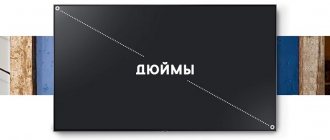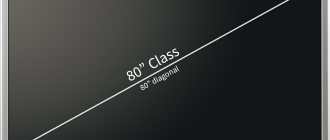Choosing a laptop PC is not an easy task. Users pay attention to what processor is on the laptop, how much memory, and batteries. They decide which laptop is better - Lenovo or Asus. But, as experts say, “if it’s inconvenient to work, even the most sophisticated features won’t save you.” Indeed, a tiny screen with a highly efficient “filling” will interfere with work.
Methods for finding out the diagonal of a laptop will save a lot of time and allow you to choose the device that is most convenient to use. Let's look into this issue on Anout.
Order professional laptop repair in Moscow or sell it for spare parts! Free diagnostics and courier service. Urgent repairs. Guarantee. Inexpensive! Call! Tel.: +7 (903) 729-32-48 or write to us by email: [email protected]
Order
Why find out the diagonal size of a laptop?
Replacing the matrix
When entering a store, the buyer already sees the dimensions of the devices. But not everyone can determine the dimensions in inches by eye. There are few reasons to carefully study sizes, but they are important:
- when replacing the matrix, you must clearly know the dimensions of the display;
- if you have to change the screen extension, you need dimensions;
- Working on a laptop with a small screen for a long time can lead to rapid fatigue.
Also, the need to clearly define the dimensions arises when replacing the screen, etc. There are several ways to clarify the parameters; users choose the most convenient options.
FAQ
Why are my models different, but the diagonal size is the same?
The reason is the different aspect ratio. For example, there are 4:3 sides (most laptops), but there are also 16:9 widescreen ones.
Find out the diagonal of the laptop screen
There are several ways to determine the diagonal, allowing you to quickly find out the necessary information. First, we list those that require a minimum amount of effort and time from the user.
- The easiest way to do this is to find the sticker on the device body. This is usually where basic information is located, including screen size.
Users who do not know the laptop model can find technical documentation or device packaging - the information of interest regarding the purchased laptop model is always indicated there.
In a situation where all these methods cannot be used, we suggest that you familiarize yourself with two other options, more complex but effective.
Method 1: Third Party Programs
There are many programs that provide detailed technical information about the device. The most popular and informative is AIDA64, which displays information about the screen as well. This program has a 30-day trial period, which is more than enough to find the answer to your question.
- Install the program and run it.
- Expand the “Display” tab and go to the “Monitor” subsection.
On the right, find the line “Monitor type” and the number that will be indicated opposite the title indicates the screen diagonal in inches.
If the software definition option is not your case, move on to the next one.
Method 2: Manual measurement
A simple method that requires you to use any measuring instrument - ruler, tape measure, tape measure.
- Place the beginning of the ruler at any bottom corner of the screen. Stretch it to the opposite upper corner (from left to right or from right to left) and look at the number in centimeters.
You have learned several easy methods for determining the diagonal of a laptop or computer screen. As you can see, this is easy to do even in the complete absence of technical data and the Internet. This knowledge can be useful both for determining the diagonal of your device and when choosing a used device, where you should not rely on the information provided by the seller, but carefully check everything yourself.
Thank the author and share the article on social networks.
To find out the diagonal of a laptop screen, look up its technical specifications on the Internet, measure the display with a tape measure and convert centimeters to inches, or use the capabilities of the AIDA64 program.
Method 1: Read in the documents
Sticker on the laptop case
The easiest way to clarify the parameters is to look at the instructions. Even if it is lost, the user manual will definitely contain the necessary information. And a few more simple ways:
- View label. There is a sticker on the bottom panel indicating the parameters of the laptop. Perhaps the numbers you are looking for will be there.
- Inspect the box. They try not to throw away packaging containers from equipment so that, if necessary, they can return the product to the seller. It is on the boxes that all the parameters and main technical characteristics are written.
The only caveat is that manufacturers often overestimate the dimensions on the packaging. For example, instead of a diagonal of 19 inches, the laptop will show 18.5 or 18.3. This is not an intentional error, but a "rounding system". So it is better to check the display dimensions using a ruler.
Question to the expert
What affects the diagonal size of a laptop?
For cost, ease of use. The manufacturer determines everything else independently. There are models with a small screen size, but enhanced technical characteristics.
Laptop information
All laptops have stickers with technical specifications. Look carefully, perhaps the screen diagonal is indicated there. What are the options? 10.1, 11.6, 12, 14 inches, etc. For example, 17.3 inches is almost 50 centimeters, because 1 inch = 2.54 cm. To avoid the hassle of converting inches to centimeters and back, use the table:
If there is no information on the screen size on the laptop case, try to find out its diagonal from the documents that were in the box when you purchased the laptop. By the way, the physical size of the display is almost always written on the box itself, so if you haven’t thrown it away, you can easily find the information you need.
If you know the exact model of your laptop, you can view its technical specifications on the manufacturer’s website or in any online store. It is better to use information from the manufacturer’s website; No matter how well-known online stores are, sometimes they encounter errors.
Method 2: Find out on the manufacturer’s website
Ratio of inches and centimeters
The official resource contains the information that the buyer needs. To find your laptop, enter the model name (on the sticker on the bottom), then look at the results.
The most popular sizes include:
- 11 inches is 27.84 cm;
- 15.6 inches is 39.624 cm;
- 17 inches is 43.18 cm;
- 19 inches is 48.26 cm.
But this data should also be double-checked and it is better to do this with a ruler in hand.
Table of screen sizes for TV, monitors and laptops
The table contains several pages. Dimensions in inches, which are converted to centimeters and based on these data the height and width are calculated
Attention! The height and width are affected by the ratio, here we used 16:9 for the calculation, this is the ratio for the vast majority of devices. If you have something else, use the calculator above
| Diagonal, in inches | Diagonal, cm | Width, cm | Height, cm |
| 11 | 27,9 | 24,36 | 13,70 |
| 11,6 | 29,5 | 25,69 | 14,45 |
| 13 | 33,0 | 28,79 | 16,20 |
| 13,3 | 33,8 | 29,46 | 16,57 |
| 14 | 35,6 | 31,01 | 17,44 |
| 14,1 | 35,8 | 31,23 | 17,57 |
| 15 | 38,1 | 33,22 | 18,69 |
| 15,6 | 39,6 | 34,55 | 19,43 |
| 16 | 40,6 | 35,44 | 19,93 |
| 16,9 | 42,9 | 37,43 | 21,05 |
| 17 | 43,2 | 37,65 | 21,18 |
| 17,3 | 43,9 | 38,31 | 21,55 |
| 18 | 45,7 | 39,86 | 22,42 |
| 18,5 | 47,0 | 40,97 | 23,05 |
| 19 | 48,3 | 42,08 | 23,67 |
| 19,5 | 49,5 | 43,19 | 24,29 |
| 20 | 50,8 | 44,29 | 24,92 |
| 21,5 | 54,6 | 47,62 | 26,78 |
| 22 | 55,9 | 48,72 | 27,41 |
| 23 | 58,4 | 50,94 | 28,65 |
| 23,5 | 59,7 | 52,05 | 29,28 |
| 23,6 | 59,9 | 52,27 | 29,40 |
| 23,8 | 60,5 | 52,71 | 29,65 |
| 24 | 61,0 | 53,15 | 29,90 |
| 25 | 63,5 | 55,37 | 31,14 |
| 26 | 66,0 | 57,58 | 32,39 |
| 27 | 68,6 | 59,80 | 33,64 |
| 28 | 71,1 | 62,01 | 34,88 |
| 29 | 73,7 | 64,23 | 36,13 |
| 30 | 76,2 | 66,44 | 37,37 |
| 31 | 78,7 | 68,66 | 38,62 |
| 31,5 | 80,0 | 69,76 | 39,24 |
| 32 | 81,3 | 70,87 | 39,86 |
| 33 | 83,8 | 73,09 | 41,11 |
| 34 | 86,4 | 75,30 | 42,36 |
| 36 | 91,4 | 79,73 | 44,85 |
| 37 | 94,0 | 81,94 | 46,09 |
| 38 | 96,5 | 84,16 | 47,34 |
| 39 | 99,1 | 86,37 | 48,59 |
| 40 | 101,6 | 88,59 | 49,83 |
| 41 | 104,1 | 90,80 | 51,08 |
| 42 | 106,7 | 93,02 | 52,32 |
| 42,5 | 108,0 | 94,13 | 52,95 |
| 43 | 109,2 | 95,23 | 53,57 |
| 44 | 111,8 | 97,45 | 54,81 |
| 45 | 114,3 | 99,66 | 56,06 |
| 46 | 116,8 | 101,88 | 57,31 |
| 47 | 119,4 | 104,09 | 58,55 |
| 48 | 121,9 | 106,31 | 59,80 |
| 49 | 124,5 | 108,52 | 61,04 |
| 50 | 127,0 | 110,74 | 62,29 |
| 51 | 129,5 | 112,95 | 63,53 |
| 52 | 132,1 | 115,17 | 64,78 |
| 53 | 134,6 | 117,38 | 66,03 |
| 54 | 137,2 | 119,59 | 67,27 |
| 55 | 139,7 | 121,81 | 68,52 |
| 57 | 144,8 | 126,24 | 71,01 |
| 58 | 147,3 | 128,45 | 72,26 |
| 59 | 149,9 | 130,67 | 73,50 |
| 60 | 152,4 | 132,88 | 74,75 |
| 61 | 154,9 | 135,10 | 75,99 |
| 63 | 160,0 | 139,53 | 78,48 |
| 64 | 162,6 | 141,74 | 79,73 |
| 65 | 165,1 | 143,96 | 80,98 |
| 66 | 167,6 | 146,17 | 82,22 |
| 67 | 170,2 | 148,39 | 83,47 |
| 69 | 175,3 | 152,82 | 85,96 |
| 70 | 177,8 | 155,03 | 87,20 |
| 72 | 182,9 | 159,46 | 89,70 |
| 73 | 185,4 | 161,67 | 90,94 |
| 74 | 188,0 | 163,89 | 92,19 |
| 75 | 190,5 | 166,10 | 93,43 |
| 77 | 195,6 | 170,53 | 95,92 |
| 80 | 203,2 | 177,18 | 99,66 |
| 81 | 205,7 | 179,39 | 100,91 |
| 82 | 208,3 | 181,61 | 102,15 |
| 84 | 213,4 | 186,04 | 104,65 |
| 85 | 215,9 | 188,25 | 105,89 |
| 86 | 218,4 | 190,47 | 107,14 |
| 89 | 226,1 | 197,11 | 110,87 |
| 90 | 228,6 | 199,32 | 112,12 |
| 94 | 238,8 | 208,18 | 117,10 |
| 98 | 248,9 | 217,04 | 122,09 |
| 100 | 254,0 | 221,47 | 124,58 |
Method 3: Take measurements manually
Measuring the diagonal with a ruler.
An ordinary ruler, which we apply along the diagonal of the display, will do. We measure only the transparent part, excluding the frame. We write down this result and get the dimensions in cm. And to clarify the dimensions in inches, we divide the centimeters by 2.54.
For example, the screen diagonal is 48.26/2.54 = 19. But such accuracy is rare, so we round the final result up.
FAQ
My laptops are the same size, but the diagonal is different - why?
It's a matter of different widths. The manufacturer can make a laptop with a diagonal of 17 inches, but the overall dimensions of the device will be equal to a laptop with a 19-inch screen.
Manual measurement
If you don’t know the laptop model, and there are no identifying marks or stickers on the case, then try measuring the diagonal manually. You will need a long ruler, tape measure or meter. If you use a tape measure, do not press it against the display to avoid accidentally damaging the screen.
You only need to measure the area where the picture is displayed. Frames around the screen do not count towards the diagonal, so there is no need to increase the size by adding them. If the tape measure does not have an inch scale, that's okay: divide the resulting value in centimeters by 2.54 to find out the diagonal in inches, or use the table above. Look at any online store to see what options there are.
Smartphone screens in inches
Smartphone screen sizes are growing. From 2007 to 2012, the average diagonal increased from 3 to 4 inches. Devices smaller than 3” are not considered smartphones at all. Two more years - and the figure has surpassed the 5″ mark. The process has not stopped, the reason is the popularity of phablets.
Phablet (from the English phone - “telephone” and tablet - “tablet”), plafond, tablet phone - a hybrid of a tablet and a smartphone. It features a larger display than the average device on the market. The trend of growing diagonals changes the term: in 2011, the Galaxy Note was considered a phablet (5.3 inches against the average 3.8), today the minimum value is 5.5 inches.
There is no clear boundary between a phablet and a tablet. It all depends on the manufacturer: Samsung considers the 7-inch Galaxy W a phone, Huawei's MediaPad X1 with a screen of the same size is a mini-tablet with a cellular communications module.
3.5″
4″
4.5″
5″
5.5″
6″
International standards: centimeters and inches
To get an approximate idea of the length and width (height) of the screen, you need to know the aspect ratio and again refer to the calculations using a school geometry course. To do this, you should calculate the sides of a square or rectangle according to the theorem.
Various models
There, from the known data, there is only a common side of two conditional triangles - the diagonal of the screen in centimeters or inches. Visualization of a smartphone for a simple user is only available if one knows what the width and height of the electronic device is in cm.
Screen diagonal - the most cunning deception in history?
Last updated:6 days ago
Reader rating for this article: 4.9
(276)
We have become accustomed to not trusting the technical characteristics of devices. A 12 megapixel camera can shoot better than an 18 megapixel camera, and a high-speed 4 GB memory can be better than a slow 6 GB memory.
But in these cases, the numbers themselves do not mislead a person. You actually get physically more memory and megapixels. The only question is their quality.
However, there is one most important characteristic of any device that has lost its meaning over the past 10 years. This is a brilliant trick that not only users, but also professional technology reviewers fell for.
Remember 7-inch tablets of 10 years ago. These were huge “shovels” that no one would even think of using as a telephone. Of course, there were desperate enthusiasts who did not hesitate to put a large “board” the size of their head to their ear in order to answer an incoming call. But it looked very comical.
However, today the huge Samsung Galaxy S20 Ultra with an almost identical 7-inch screen (6.9″) looks quite harmonious. Moreover, you can operate such a device with at least one hand.
And let’s also remember the simply “giant” pocket computer HTC Advantage X7500 with its 5-inch screen:
This gadget was very convenient to work with documents, read books and surf the Internet. The only problem was its size.
But 10 years later, the Samsung Galaxy S7 smartphone comes out with a slightly larger screen:
Only now it is not a bulky monster, but an elegant and fairly compact device.
Of course, we see that the frames around the screen have been significantly reduced, and the display itself looks different: if before it was almost square, now it has become more elongated.
It turns out that the screen size is the same, only brilliant manufacturers managed to change its shape so successfully and remove the frames that now it easily fits into any pocket? Not really.
The truth is that a modern 6-inch screen is physically a quarter smaller than a 6-inch screen from 10 years ago . How can this be? Were even inches better before?
Screen diagonal has nothing to do with its actual size
And this is really true. For example, for many years in a row, Apple released the iPhone with the Plus prefix, whose screen diagonal was increased from 4.7 to 5.5 inches.
But then a much more compact iPhone X came out with a large 5.8-inch screen:
iPhone 8 Plus (left) and iPhone X (right)
Many observers then said that this was the largest display in the history of the iPhone. Of course, part of the new screen was eaten up by the “bangs”, and its edges were very rounded. But in fact, the main problem was that the “new 5.8 inches” turned out to be physically smaller than the “old 5.5 inches” of the previous iPhone 8 Plus.
Even if the new iPhone X didn't have the notch and rounded corners, the iPhone 6/7/8 Plus screens were still larger by almost a square centimeter!
This became the main trick of the manufacturers. The diagonal of a smartphone has turned from a very useful characteristic into a marketing tool that misleads the user.
Last year, Apple released a “miniature” iPhone 12 mini with a 5.4″ screen. At first glance, it seems that using such a screen today is inconvenient. But then we remember that not long ago even Android flagships didn’t have such large displays. The screen diagonal of the same Samsung Galaxy S7 was 5.1″, which is much smaller than the diagonal of the “small” iPhone.
But in reality it’s the other way around - the 5.1″ screen from Samsung was larger than the new 5.4″ screen from Apple. Again, we're not talking about cutouts or corners. The area of the “old inches” itself is larger than the area of the “new inches”.
To finally convince you of the absurdity of the current situation, let's compare the fitness trackers Xiaomi Mi Band 6 and Huawei Band 6. According to the characteristics, the screen of the first bracelet (1.56″) is noticeably larger than the screen of the second (1.46″). In fact, we see exactly the opposite:
Xiaomi screen (left) and Huawei screen (right)
It is obvious that the screen on the right (1.46 inches) is almost twice as large as the screen on the left (1.56 inches), although the diagonals stubbornly indicate the opposite.
Now Xiaomi can safely say that it has released a compact fitness bracelet with the largest screen in the world. And this statement will be both true and false.
Aspect ratio is the key!
When the first televisions appeared, their screens were completely round. Then the manufacturers covered the circle a little at the top and bottom, making the display more rectangular:
An example of an “antediluvian” TV
As a result, the world came to completely rectangular displays with an aspect ratio of 4:3 , in which the screen width was always about 1.33 times greater than the height. For example, if the screen width was 12 cm, then its height was 9 cm and the diagonal was 15 cm:
Any characteristic was suitable to indicate size - its width, height or diagonal. In all these cases, it was possible to easily and conveniently compare any screens with each other.
Of course, marketers voted for the diagonal as the largest value among others. After all, the higher the number, the more attractive the product looks in the eyes of the buyer. What kind of TV would you buy - one with a matrix size of fifteen or nine?
Thus, we got an excellent metric - screen diagonal , which worked perfectly and made it very easy to directly compare any TV with each other. The larger the diagonal, the larger the screen area.
But then the manufacturers did one brilliant trick - they took the diagonal and tilted it slightly to the side (turned it clockwise):
It would seem, what's wrong with that? Well, we tilted the diagonal a little to the side, but the dimensions remained the same.
In fact, everything has changed! If we draw a screen around the new diagonal and compare it with the previous one, we will see the following picture:
Both displays have a diagonal of 15 cm and the vast majority of buyers will assume that their sizes are the same. It’s just that one display is a little wider, and the other is a little taller: 12x9 cm versus 13x7.4 cm.
But if we compare the main parameter - the area of the screens , we will find that in the first case it will be 108 cm2, and in the second - 96 cm2. Somewhere “magically” as much as 12 square centimeters disappeared!
Now our TV has a new aspect ratio - 16:9 . Its width is approximately 1.78 times greater than its height, and its area with the same diagonal is 11% less!
Zoo Diagonals
And then the real fun began - manufacturers began to rotate the diagonal as they pleased! For example, here are three smartphones with an identical screen diagonal - 3.5 inches :
From left to right: iPhone, Blackberry and Nokia
Naturally, any user can see that these screens are different in shape: one is elongated, the other is square, the third is something in between. Accordingly, it is more convenient to watch movies on one display, and to work with text on another.
But the trick here is that inches don't tell the buyer anything. After all, with the same diagonal, the screen area of the iPhone is 36.5 cm2, Blackberry is 39.5 cm2, and Nokia is 33.8 cm2.
Just think: the difference between the largest and smallest “3.5-inch screen” is almost 6 square centimeters ! And this is on a tiny mobile device, where every millimeter matters.
Now let's get back to more modern devices. Take any electronic reader with a 6-inch screen diagonal and compare it with the 6-inch Sony Xperia 10 smartphone. With the same diagonal, the area of the first screen is 111.5 cm2, and the second is 84 cm2!
This is simply an incredible difference, although the characteristics of both devices indicate an identical diagonal - 6 inches.
Of course, manufacturers can also indicate the aspect ratio of the screens in a separate line (in the first case it is 3:4, in the second it is 21:9). But for most ordinary buyers, this will only mean that the ereader screen is wider, and the smartphone screen is narrower and more elongated.
People will continue to mistakenly think that both devices offer the same "screen amount", that is, the same area. And this is fundamentally wrong!
If we wanted to have “the same amount of screen” on the 6-inch Sony Xperia 10 as on the 6-inch e-reader, then the manufacturer would have to increase the smartphone display to 6.9″ (without changing the aspect ratio)! Then the areas of these screens would be equal.
What's the moral of this story?
Screen diagonal in the modern world is a very vague characteristic that misleads many people. There's a zoo of different aspect ratios on the market today. Here are just a few examples:
- Xiaomi Mi 11 Pro - 20:9
- Samsung Galaxy Fold 3 - 25:9
- iPhone 12 - 19.5:9
- iPhone SE 2021 - 16:9
- Sony Xperia 1 III - 21:9
- Samsung Galaxy Note 9 - 18.5:9
And comparing the sizes of these screens only diagonally is completely wrong. For example, the external screen on the Samsung Galaxy Fold 3 has a quite decent diagonal of 6.2 inches. The manufacturer even boasts about this size and emphasizes this detail.
But when we take into account its aspect ratio, we get a display area of 79 cm2, which is even less than a “normal” 5.4-inch screen!
Is Samsung deceiving its customers by claiming a 6.2-inch screen? Formally, no. There really is a diagonal of this size here. But a user who is accustomed to 6-inch matrices expects to get about the same amount of screen in a new smartphone. However, he will be greatly disappointed.
Therefore, before evaluating the screen of any device, be sure to pay attention to the diagonal and aspect ratio. Screen area is the most important parameter that all manufacturers hide.
For reading books, the 6-inch screen of any e-reader will be much more convenient than the 6.7-inch screen of the Galaxy S21+ smartphone, since the e-reader’s screen is simply larger, despite its smaller diagonal.
And these diagonal tricks became one of the reasons for such a “jump” in screen sizes. Previously, 6-inch displays were found only on tablets and e-readers, but today even a budget smartphone can boast an even larger diagonal.
But this is just an illusion! In the past, “inches were bigger.”
If you still don’t understand what the trick is, then I suggest taking a 6.5″ diagonal and placing it almost vertically. Now let’s compare a normal screen and a vertical one with an identical diagonal:
No one will argue with the fact that the blue screen on the right is just a small piece of the original screen on the left. Although formally both of these screens have an identical diagonal - 6.5 inches!
Moreover, if we placed a 6.5-inch screen, whose diagonal is rotated almost vertically (in the picture on the right), inside a 6.5-inch screen, in which the diagonal is located at an angle of 60° (in the picture on the left), we would get such a funny picture :
As you can see, with the same diagonal, the area of the second screen occupies only 10% of the area of the first!
How to calculate the area, width and height of a screen, knowing only its diagonal and aspect ratio?
As a small bonus, I would like to provide a very simple formula by which anyone can calculate the real width and height of a gadget’s screen, knowing only its diagonal and aspect ratio.
They say that this formula was invented by one person about 2500 years ago and it looks like this:
Here d is the diagonal, a and b are the aspect ratio.
For example, if you want to know the real width and height of the Redmi Note 10 Pro display, then look at its diagonal (6.67″) and aspect ratio (20:9) in the characteristics. It turns out that here d = 6.67, a = 20 and b = 9. Substitute the values into the formula:
And we get that the screen height is 6.08 inches and the width is 2.74 inches. To convert this to centimeters, we multiply the values by 2.54 and get the screen dimensions: 15.5 x 6.9 cm . To find out the area, simply multiply the height by the width and get 107 cm2 .
In this way, you can compare the actual sizes of screens and their areas, taking into account not only the diagonal, but also the aspect ratio.
Alexey , head. ed. Deep Review
PS
Don’t forget to subscribe in Telegram to the first popular science site about mobile technologies - Deep-Review, so as not to miss the very interesting materials that we are currently preparing!
How would you rate this article?
Click on the star to rate it
There are comments at the bottom of the page...
Write your opinion there for all readers to see!
If you only want to give a rating, please indicate what exactly is wrong?
Why do you need an exact screen size?
First of all, you need to know the real size in case of failure of the laptop display. To replace this element, it is strictly not recommended to be guided by general data. There are cases when users, guided by the inscriptions on the box, ordered a new matrix, but it did not fit because it was larger or smaller than what was needed. Accuracy is important here, and general information will not do.
Some people need to know the actual dimensions out of pure curiosity. It is always interesting to find out how unscrupulous manufacturers can be and how many inches they have deceived users. Although this happens quite rarely.











